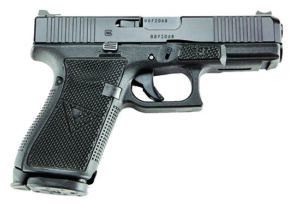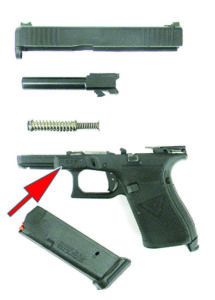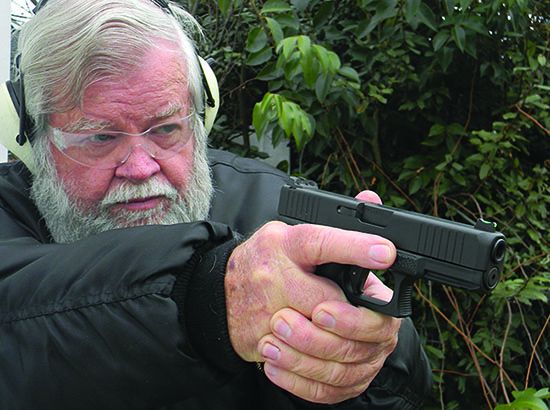The most popular carry gun in America is a polymer-frame striker-fired 9mm. While the smaller slim-line 9mms sell the most, larger pistols, such as the SIG P365, Smith & Wesson Shield Plus, and the Glock 19, nevertheless maintain strong followings. Here, we are looking at 9mm pistols in this larger footprint, including a:
● Shadow Systems MR920 Elite SS-1009, $979;
● Wilson Combat Vickers Edition Glock 19 upgrade, $1375; and a
● Kimber KDS9C 3100010, $1318, a Commander-length 1911. Here’s what we thought of them:
Wilson Combat Vickers Edition Glock 9mm Luger
$1375
Gun Tests grade: B
This is a sterling performer, with a sterling price tag, which gave us pause. Reliability is the foremost attribute of the Glock pistol. The trigger action and sights are the primary Wilson improvements. This is a pricey Glock, but it is nonetheless a Glock improved to the greatest degree possible.

| Action Type | Double action, striker fired |
| Overall Length | 7.4 in. |
| Overall Height | 5.04 in. |
| Maximum Width | 1.3 in. |
| Weight Unloaded | 25.75 oz. |
| Weight Loaded | 30.75 oz. |
| Slide | Black Phosphate finished steel |
| Slide Retraction Effort | 16.7 lbs. |
| Receiver | Black Polymer |
| Front Strap Height | 2.0 in. |
| Rear Strap Height | 3.6 in. |
| Barrel Length | 4.1 in |
| Grip | Replaceable back strap |
| Grip Thickness | 1.3 in. |
| Grip Circumference | 6.0 in. |
| Magazines | (3) 15 round |
| Rear Sight | Fixed Battlesight |
| Front Sight | Fiber optic, fixed |
| Trigger Pull Weight | 4.1 lbs. |
| Trigger Span | 2.45 in. |
| Sight Radius | 7.0 in. |
| Safety | Trigger lever |
| Warranty | Limited Lifetime (Wilson Combat) |
| Telephone | (800) 955-4856 |
| Website | WilsonCombat.com |
| Made In | U.S. |
Our Wilson Combat version is the Vickers Tactical Glock built on a Glock 19. The pistol is not optics ready, but like all modern Glock handguns, it features a light rail and replaceable grip inserts. This Glock Generation 5 9mm may be offered at a higher price with a match-grade barrel; there are several options on the Wilson Combat website. There are two categories: guns already done up for sale and a list of options. As an example, our pistol features many upgrades, but retains the standard Glock barrel. Considering its likely use as a personal-defense arm, and that this seems to be the new Glock Marksman barrel, it isn’t much of a downgrade. The Paul Howe package is similar but features a Wilson Combat barrel for $1560. So, you can pay your money and take your choices.
The pistol tested here features a stippled tactical frame and stippled thumb pads. The greatest improvement over the factory Glock is a tuned tactical action with a TangoDown/Vickers trigger. The rear sight is the Wilson Combat Battlesight, and the front sight is a fiber optic. A TangoDown tactical grip plug adds balancing weight, which was welcome. The magazines feature TangoDown basepads. The pistol also features a custom-grade magazine release and slide stop. The pistol is supplied with three magazines.
The Wilson Combat Glock weighs 2.25 ounces more than a standard Glock 19 due to the TangoDown grip insert in the back. The difference is noticeable in firing the Wilson Combat Glock side by side with a stock Glock 19.

During the firing test, we found the Wilson Combat Battlesight/fiber-optic combination excellent for combat use. We fired the mixed 60 rounds of 9mm ball ammunition and finished up with 50 rounds of Fiocchi FMJ without any problems. There were raters who fired better groups in rapid fire with the Wilson Combat rather than the Kimber, but both shaded the Shadow Systems MR920 Elite to some extent. The Wilson Combat’s trigger action, breaking at 4.6 pounds, is simply superb for a striker-fired pistol. We contacted Wilson Combat and were told that while we could purchase Glock action parts, the internal polishing is done at Wilson Combat and very few shooters would be able to approach their level of expertise.
The pistol sits in the hand well and shoots very well, very quickly and very accurately. The balance of abrasion and adhesion is the best of the test. In bench accuracy, we were surprised to find our groups were better than anything expected with a Glock-based pistol, as small as 1.4 inches with the Federals, slightly better than the Kimber at 1.5 inches with the same load. The Kimber slightly beat the Wilson Combat with the other two loads. The Wilson pistol outperforms the Shadow Systems in combat shooting and bench accuracy. We liked the Wilson Combat gun; its reliability is predictably Glock class — after all, it is a modified Glock. Still, we rated the pistol down a full grade on optics mounting because it will not accept optics at all. If you want a similar pistol that is optics ready, Wilson Combat has options that will cost more.
So, we get it. We were scratching our heads, too. The only Grade A gun and the Best Buy is the slowest in combat firing and the least accurate off the bench. But that isn’t the whole story.
All of these guns are very accurate and combat capable, two just outshot the third, and that was not constant in every hand. Performance-wise, the results were tight. The Shadow Systems pistol offers a trouble-free optics system, will accept a combat light, will take a suppressor, and is affordable. We like the Elite as is, but, frankly, after firing the 1.5-ounce-lighter Elite pistol next to the Wilson, we were ready to fit a TangoDown grip weight into the Elite.
Our Team Said: Our Pick for combat is the Wilson Combat Glock. Reliability and performance are very respectable, and if price is no object, we’re certain you’ll be pleased with this pistol. The Kimber is a good effort at modernizing the 1911. But it isn’t our first choice. Even the diehard 1911 fan among the raters was swayed by the excellent performance of the Wilson Combat Glock. No bad guns here.
| 9MM LUGER RANGE DATA | |||
| Fiocchi 115-grain FMJ | Kimber KDS9C | Shadow Systems MR920 Elite | Wilson Combat Vickers Edition Glock |
| Average Velocity | 1154 fps | 1132 fps | 1168 fps |
| Muzzle Energy | 340 ft.-lbs. | 327 ft.-lbs. | 348 ft.-lbs. |
| Smallest Group | 1.6 in. | 2.25 in. | 1.75 in. |
| Average Group | 2.2 in. | 2.95 in. | 2.45 in. |
| Black Hills 124-grain JHP | Kimber KDS9C | Shadow Systems MR920 Elite | Wilson Combat Vickers Edition Glock |
| Average Velocity | 1101 fps | 1130 fps | 1150 fps |
| Muzzle Energy | 334 ft.-lbs. | 352 ft.-lbs. | 364 ft.-lbs. |
| Smallest Group | 1.8 in. | 2.6 in. | 1.95 in. |
| Average Group | 2.3 in. | 3.0 in. | 2.2 in. |
| Federal HST 147-grain JHP | Kimber KDS9C | Shadow Systems MR920 Elite | Wilson Combat Vickers Edition Glock |
| Average Velocity | 999 fps | 1012 fps | 1022 fps |
| Muzzle Energy | 320 ft.-lbs. | 334 ft.-lbs. | 341 ft.-lbs. |
| Smallest Group | 1.5 in. | 2.0 in. | 1.4 in. |
| Average Group | 1.9 in. | 2.4 in. | 2.0 in. |
How we tested: We fired groups at 25 yards from a benchrest position using an MTM Case-Gard K-Zone Shooting Rest. We used a Competition Electronics Pro Chrony to measure muzzle velocities. Notes: JHP = jacketed hollow point. FMJ = full metal jacket.
Written and photographed by Gun Tests Staff, using evaluations from Gun Tests Team members. GT

























